Raw bit depth and Dynamic Range
Mar 12, 2021 08:25:48 #
trinhqthuan
Loc: gaithersburg
selmslie wrote:
First the Capture One session showing all eight im... (show quote)
Thanks so much for your works, time and share to us. I have D300, D7100 and D750 all can record either 12 bit or 14 bit. For conservative reason I shoot in 14 bit without actually seeing the difference. Now knowing that I just use the most capability that I paid for my cameras. Thanks s s s



Mar 12, 2021 08:50:49 #
Bbarn
Loc: Ohio
The math dictates a 4X difference in range of possible data between 12-bit and 14-bit data. So the potential benefit of the additional two bits of data is significant. The example in the OP is a demonstration of how image quality can improve with 2 additional bits of possible data.
Mar 12, 2021 09:25:23 #
Ysarex
Loc: St. Louis
selmslie wrote:
The effect is clear if you look at the evidence. It's obvious in the ISO 100 sample and it can be seen in the ISO 400 sample if you look closely. If you can't see it then you have not looked.
I have looked. Now it's your turn to describe what you see.
I have looked. Now it's your turn to describe what you see.
I see that it's possible to get more DR from a given 12 bit camera than a given 14 bit camera. And so even though in a single camera that can switch bit depth it's correct to say that the result will be altered DR it's not possible to generalize that to 12 and 14 bit cameras. So we can't simply make the claim that how much DR is available from different cameras is a function of their bit depth. What you describe is true for a specific camera that can switch bit depth but it's not true for cameras of different bit depth. Therefore there has to be more involved in determining DR than bit depth since the bit depth/DR relationship you've identified only applies in any one specific camera. The way you presented the topic suggests a relationship of X bit depth = X DR applies across camera brands and models and I see that it doesn't.
Mar 12, 2021 09:27:36 #
R.G. wrote:
... The reason why the dark areas got a special mention is because that's where noise (and in more general terms a lack of smoothness) is most noticeable. In the posted examples the difference in bit depth can be seen most clearly in the level of smoothness in the dark areas. It's not obvious but it's there. It would have been more obvious if a bigger difference in bit depth had been used.
That's the point. Once you get into the deep shadows it's difficult to separate the noise from the lack of tonality/smoothness by looking at a pair of images.
If we control the noise by using the same exposure and ISO, what's left is the effect of the bit depth.
Unless you have an aversion to looking at raw histograms, the answer can be found there. The 6 stop difference between the first and second images (both 12-bit) is because the ISO was changed from 6400 to 100. The two stop improvement between the second and third images (both at ISO 100) is from switching from 12-bit to 14-bit.
This test was done with a Nikon Df.
ETTR exposure at 12-bit, the red and green channels are very close to the 4095 limit
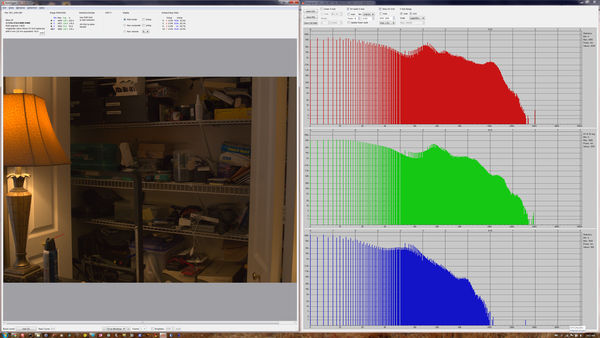
(Download)
Same exposure, ISO 100 12-bit
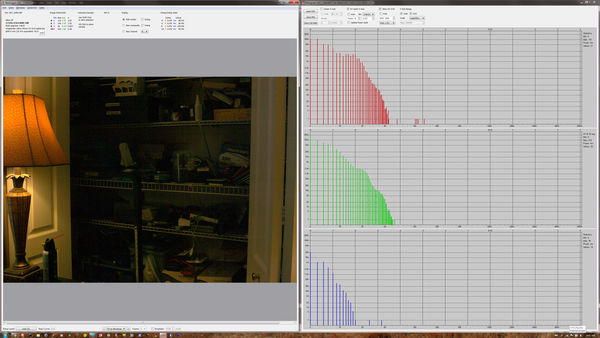
(Download)
Same exposure, ISO 100 14-bit
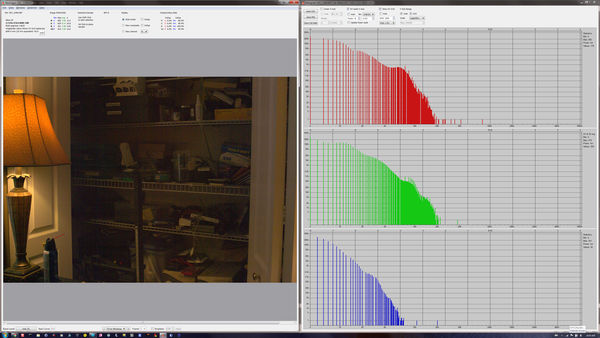
(Download)
Mar 12, 2021 09:33:01 #
Ysarex wrote:
I see that it's possible to get more DR from a given 12 bit camera than a given 14 bit camera. ...
You are off topic.
We are not comparing two different cameras. We are looking at the effect of the bit depth setting on the same camera.
I just did the test with the Df and found the same difference.
Mar 12, 2021 09:44:30 #
Bbarn
Loc: Ohio
If a sensor's capability exceeds 12 bits, additional bits can be utiiized to improve image quality (as demonstrated here).
Mar 12, 2021 09:44:46 #
Ysarex
Loc: St. Louis
Bbarn wrote:
The math dictates a 4X difference in range of possible data between 12-bit and 14-bit data. So the potential benefit of the additional two bits of data is significant. The example in the OP is a demonstration of how image quality can improve with 2 additional bits of possible data.
Yes, but it is also possible (it's done) to engineer a 12-bit camera to record an overall total range that is greater than the total range recorded by a 14-bit camera. Think in terms of a staircase. The staircase has to reach from one floor to the next -- total range. One staircase is built with bigger and fewer steps while a second staircase is built with more and smaller steps. Both reach to the same place so the total range is the same. There is no uniform X-bits = X data range compliance standard across our different cameras.
Mar 12, 2021 09:52:29 #
Ysarex
Loc: St. Louis
selmslie wrote:
You are off topic.
We are not comparing two different cameras.
We are not comparing two different cameras.
I am not off topic. Your example looked at the difference in bit depth in the same camera, but your post title and text suggested that your example could be generalized not just to another single camera but to different cameras -- it can not. I'm just making sure that's clear and that's on topic. And if that's clear I'm happy.
Mar 12, 2021 10:12:39 #
Ysarex wrote:
I am not off topic. Your example looked at the difference in bit depth in the same camera, but your post title and text suggested that your example could be generalized not just to another single camera but to different cameras -- it can not. I'm just making sure that's clear and that's on topic. And if that's clear I'm happy.
You still don't see the point. You are off topic because you are still trying to introduce another variable, a second camera.
Here is the same test with a different camera (Z7) at two different bit depths. The results are the same. There is still a 2 stop improvement in shadow resolution.
So that's three separate cameras that all behave the same when the 12/14 bit selection is changed. I'm out of cameras that offer the choice.
It looks like it is a universal difference.
ISO 6400 at 12-bit to arrive at ETTR (ignoring some specular highlights)
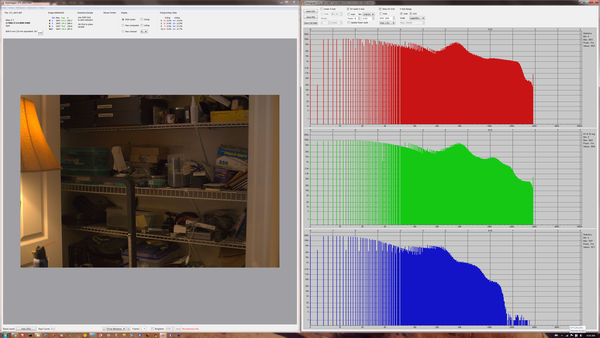
(Download)
12-bits, same exposure at ISO 100
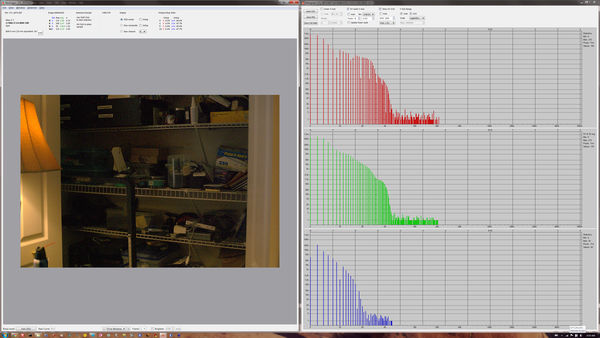
(Download)
14-bits, same exposure at ISO 100
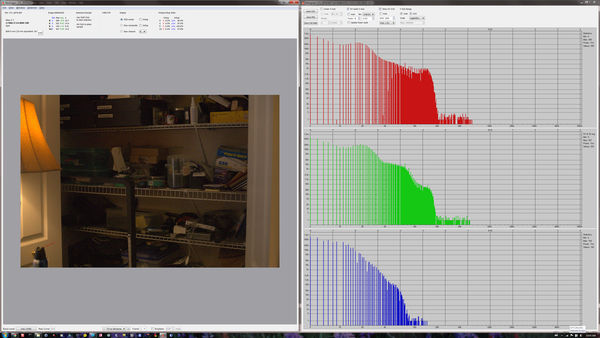
(Download)
Mar 12, 2021 10:21:25 #
Ysarex
Loc: St. Louis
selmslie wrote:
You still don't see the point. You are off topic because you are still trying to introduce another variable, a second camera.
I am not off topic. I am not trying to introduce another variable. You implied that other variable and I am clarifying that your implication of the other variable would be incorrect -- I'm making sure no one get's misled. https://www.uglyhedgehog.com/t-688906-1.html#12069664
Mar 12, 2021 10:21:28 #
Ysarex wrote:
Yes, but it is also possible (it's done) to engineer a 12-bit camera to record an overall total range that is greater than the total range recorded by a 14-bit camera. ....
First, you are referring to two different cameras.
Second, your assumption that it may be possible has not basis in reality. If it could be done, why wouldn't the manufacturer simply use a 14-bit raw file?
You are just spitting into the wind.
And you are still off topic and trying to hijack this thread. We will all appreciate it if you stopped.
Mar 12, 2021 10:25:00 #
Ysarex wrote:
I am not off topic. I am not trying to introduce another variable. You implied that other variable and I am clarifying that your implication of the other variable would be incorrect -- I'm making sure no one get's misled. https://www.uglyhedgehog.com/t-688906-1.html#12069664
Yes, you are off topic and trying to hijack the thread.
If you continue along this line I will not respond to you any further.
Mar 12, 2021 10:25:03 #
Ysarex wrote:
I see that it's possible to get more DR from a giv... (show quote)
So, his title wasn't accurate enough to suite your detail analysis of every word. But Bbarn's response is reasonable and therefore it is "reasonable" to generalize for other similar cameras. However, you can always make the effort to test YOUR camera to see if its true. Don't beat semantics to death. Its boring after a while. This is not a classroom. Its real life.
Mar 12, 2021 10:28:11 #
Ysarex
Loc: St. Louis
selmslie wrote:
First, you are referring to two different cameras.
Second, your assumption that it may be possible has not basis in reality.
Second, your assumption that it may be possible has not basis in reality.
Yes it does. Go to DXO and compare these two same year cameras from Nikon: D3400 and D5.
selmslie wrote:
And you are still off topic and trying to hijack this thread.
I am not. I'm clarifying an important point because of your implication to the contrary: https://www.uglyhedgehog.com/t-688906-1.html#12069664
Mar 12, 2021 10:34:33 #
Bbarn
Loc: Ohio
Ysarex wrote:
Yes, but it is also possible (it's done) to engine... (show quote)
Of course such a technique also increases the magnitude of any steps in noise as well. So the potential S/N would be less.
If you want to reply, then register here. Registration is free and your account is created instantly, so you can post right away.


